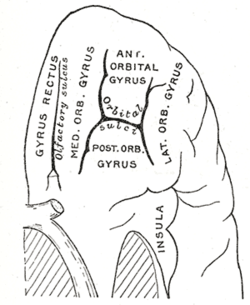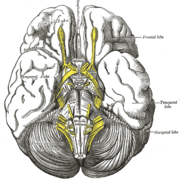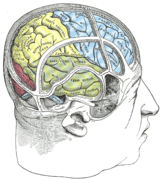Frontal lobe
This article needs additional citations for verification. (April 2011) |
| Frontal lobe | |
|---|---|
 | |
| Details | |
| Part of | Cerebrum |
| Artery | Anterior cerebral Middle cerebral |
| Identifiers | |
| Latin | lobus frontalis |
| Acronym(s) | FL |
| MeSH | D005625 |
| NeuroNames | 56 |
| NeuroLex ID | birnlex_928 |
| TA98 | A14.1.09.110 |
| TA2 | 5445 |
| FMA | 61824 |
| Anatomical terms of neuroanatomy | |
The frontal lobe is an area in the brain of mammals, located at the front of each cerebral hemisphere and positioned anterior to (in front of) the parietal lobe and superior and anterior to the temporal lobes. It is separated from the parietal lobe by a space between tissues called the central sulcus, and from the temporal lobe by a deep fold called the lateral (Sylvian) sulcus. The precentral gyrus, forming the posterior border of the frontal lobe, contains the primary motor cortex, which controls voluntary movements of specific body parts.
The frontal lobe contains most of the dopamine-sensitive neurons in the cerebral cortex. The dopamine system is associated with reward, attention, short-term memory tasks, planning, and motivation. Dopamine tends to limit and select sensory information arriving from the thalamus to the fore-brain. A report from the National Institute of Mental Health says a gene variant that reduces dopamine activity in the prefrontal cortex is related to poorer performance and inefficient functioning of that brain region during working memory tasks, and to slightly increased risk for schizophrenia.
Anatomy

On the lateral surface of the human brain, the central sulcus separates the frontal lobe from the parietal lobe. The lateral sulcus separates the frontal lobe from the temporal lobe.
The frontal lobe can be divided into a lateral, polar, orbital (above the orbit; also called basal or ventral), and medial part. Each of these parts consists of particular gyri:
- Lateral part: Precentral gyrus, lateral part of the superior frontal gyrus, middle frontal gyrus, inferior frontal gyrus.
- Polar part: Transverse frontopolar gyri, frontomarginal gyrus.
- Orbital part: Lateral orbital gyrus, anterior orbital gyrus, posterior orbital gyrus, medial orbital gyrus, gyrus rectus.
- Medial part: Medial part of the superior frontal gyrus, cingulate gyrus.
The gyri are separated by sulci. E.g., the precentral gyrus is in front of the central sulcus, and behind the precentral sulcus. The superior and middle frontal gyri are divided by the superior frontal sulcus. The middle and inferior frontal gyri are divided by the inferior frontal sulcus.
In humans, the frontal lobe reaches full maturity around only after the 20s,[1] marking the cognitive maturity associated with adulthood.
Dr. Arthur Toga, a UCLA professor of neurology, found increased myelin in the frontal lobe white matter of young adults compared to that of teens. A typical onset of schizophrenia in early adult years correlates with poorly myelinated and thus inefficient connections between cells in the fore-brain.
Function
The executive functions of the frontal lobes involve the ability to recognize future consequences resulting from current actions, to choose between good and bad actions (or better and best), override and suppress unacceptable social responses, and determine similarities and differences between things or events. Therefore, it is involved in higher mental functions.
The frontal lobes also play an important part in retaining longer term memories which are not task-based. These are often memories associated with emotions derived from input from the brain's limbic system. The frontal lobe modifies those emotions to generally fit socially acceptable norms.
Psychological tests that measure frontal lobe function include finger tapping, Wisconsin Card Sorting Task, and measures of verbal and figural fluency.[2]
Psychosurgery
In the early 20th century, a medical treatment for mental illness, first developed by Portuguese neurologist Egas Moniz, involved damaging the pathways connecting the frontal lobe to the limbic system. Frontal lobotomy (sometimes called frontal leucotomy) successfully reduced distress but at the cost of often blunting the subject's emotions, volition and personality. The indiscriminate use of this psychosurgical procedure, combined with its severe side effects and dangerous nature, gained it a bad reputation. The frontal lobotomy has largely died out as a psychiatric treatment. More precise psychosurgical procedures are still used, although rarely. They may include anterior capsulotomy (bilateral thermal lesions of the anterior limbs of the internal capsule) or the bilateral cingulotomy (involving lesions of the anterior cingulate gyri) and might be used to treat otherwise untreatable obsessional disorders or clinical depression.
Theories of function
Theories of frontal lobe function can be differentiated into four categories:
- Single-process theories. Posit "that damage to a single process or system is responsible for a number of different dysexecutive symptoms” (Burgess, 2003, p. 309).
- Multi-process theories. Propose “that the frontal lobe executive system consists of a number of components that typically work together in everyday actions [(heterogeneity of function)]“ (Burgess, 2003, p. 310).
- Construct-led theories. Assume “that most if not all frontal functions can be explained by one construct (homogeneity of function) such as working memory or inhibition” (Stuss, 1999, p. 348; cf. Burgess & Simons, 2005).
- Single-symptom theories. Suggest that a specific dysexecutive symptom (e.g., confabulation) is related to the processes and construct of the underlying structures (cf. Burgess & Simons, 2005).
Stuss (1999) suggests a differentiation into two categories according to homogeneity and heterogeneity of function.
Further theoretical approaches to frontal lobe function include:
- Grafman's managerial knowledge units (MKU) / structured event complex (SEC) approach (cf. Wood & Grafman, 2003)
- Miller & Cohen's integrative theory of prefrontal functioning (e.g. Miller & Cohen, 2001)
- Rolls's stimulus-reward approach and Stuss's anterior attentional functions (Burgess & Simons, 2005; Burgess, 2003; Burke, 2007).
It may be highlighted that the theories described above differ in their focus on certain processes/systems or construct-lets. Stuss (1999) remarks that the question of homogeneity (single construct) or heterogeneity (multiple processes/systems) of function “may represent a problem of semantics and/or incomplete functional analysis rather than an unresolvable dichotomy” (p. 348). However, further research will show if a unified theory of frontal lobe function that fully accounts for the diversity of functions will be available.
Damage
Damage to the frontal lobes can lead to a variety of results:
- Mental flexibility and spontaneity are impaired, but IQ is not reduced.
- Talking may increase or decrease dramatically.
- Perceptions regarding risk-taking and rule-abiding are impaired.
- Socialization can diminish or increase.
- Orbital frontal lobe damage can result in peculiar sexual habits.
- Dorsolateral frontal lobe damage reduces sexual interest.
- Creativity is diminished or increased as well as problem solving skills.
- Distraction occurs more frequently.
- Loss of smell and/or taste.
Evolution
For many years, many scientists thought that the frontal lobe was disproportionately enlarged in humans compared to other primates. They thought that this was an important feature of human evolution and was the primary reason why human cognition is different from that of the other primates. However, this view has been challenged by newer research. Using magnetic resonance imaging to determine the volume of the frontal cortex in humans, all extant ape species and several monkey species, Semendeferi et al. found that the human frontal cortex was not relatively larger than the cortex in the other great apes but was relatively larger than the frontal cortex in the lesser apes and the monkeys.[3]
Additional images
See also
- Brain lobes
- Broca's Area
- Limen insulae
- Regions in the human brain
- Phineas Gage - Railroad worker who survived a metal rod being driven through his forebrain
References
- ^ Giedd, Jay N.; Blumenthal, J; Jeffries, NO; Castellanos, FX; Liu, H; Zijdenbos, A; Paus, T; Evans, AC; Rapoport, JL (October 1999). "Brain Development during childhood and adolescence: a longitudinal MRI study" (PDF). Nature Neuroscience. 2 (10): 861–863. doi:10.1038/13158. PMID 10491603.[dead link]
- ^ Kimberg, D.Y., Farah, M.J. A unified account of cognitive impairments following frontal lobe damage: the role of working memory in complex, organized behavior. J. Exp. Psychol. Gen. 1993 122(4):411-28
- ^ K. Semendeferi, A. Lu, S. K. GoVredi, N. Schenker, and H. Damasio (2002). "Humans and great apes share a large frontal cortex". Nature Neuroscience. 5 (3): 272–276. doi:10.1038/nn814. PMID 11850633.
{{cite journal}}: CS1 maint: multiple names: authors list (link)







